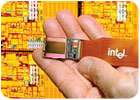
If you haven’t been, the Consumer Electronics Show – 2006 CES International aimed at “Defining Tomorrow’s Technology” – is the ultimate digital playground for music, video and gadgetry. It’s both awe inspiring and mind numbing. And while there are amazing innovations, the many applications serving 24/7 media-consuming couch potatoes are worrisome.
Still, it is important to recognize that new consumer technologies have commercial security applications and these are being integrated into enterprise systems. In addition to shin splints and a souvenir RFID casino chip, CES gave me a first look at exciting crossover technologies.
Remote Employees
Numerous companies at CES promoted security solutions for the home office worker, growingly important as enterprises depend on employees off-site. Some solutions were good; others poor. Will they meet your standards? Will you pay for them and support them? Will home-based employees use them?With home-based employees, there are real issues surrounding physical and intellectual property security. While your office may be a fortress, an employee’s home may not. And thicker manuals of compliance rules will not improve security. The prediction is that this trend will add complexity, cost and responsibility.

Off-site workers; on-site security concerns. At CES 2006, Panasonic’s John Burnham, director of strategic alliances and business development, illustrated how a new 1 GB SD Memory Card can hold the equivalent of a briefcase full of sensitive documents.
Biometrics
Let the skepticism continue, but biometrics adds real value to security programs. Initially a password replacement for access ID, a next step is to authenticate transactions. In addition to laptops, readers are on cell phones from carriers that no longer want to give credits for calls made on lost or stolen phones. Enterprise security executives now apply biometrics more aggressively to physical entrances as device size and cost continue to fall. At CES, a fingerprint reader strip, including software, listed under $5.
Bigger high-definition displays. New microdisplay technology from Intel, Liquid Crystal On Silicon, got a CES preview. The aim: large-screen TVs with clearer pictures for less than $2,000 for home theaters but also security command centers.
Empowering Officers
Security officers will have access to the same view as the central console thanks to mobile, real-time streaming video. If you have 8 screens in front of you, you will be able to place those camera images on mobile handhelds while talking about the best course of action. Also incorporated: GPS and mapping. (For more on guarding, see this issue’s special section.)Simplicity
Beyond their proliferation, key surveillance technologies will become intuitive as well as more human-centric. The research that drives consumer electronics ease of use is making its way into security systems. Touch panel screens and mobile devices for game playing, for example, will offer the same ease of use in a security application. It doesn’t matter how fantabulous the technology is, if people can’t use it, then it is useless.I passed on seeing the two Toms (Hanks and Cruise) and hearing Steve Tyler perform. I missed the visionaries including Semel of Yahoo, Gates of Microsoft and Schmidt of Google. Sorry Ellen DeGeneres, no jokes for me. I took advantage of an invitation from the Wynn Las Vegas and Patricia Fisher, who was on our January cover, to enjoy a first class tour of their world class hotel - and that was worth all the taxi lines in Las Vegas.